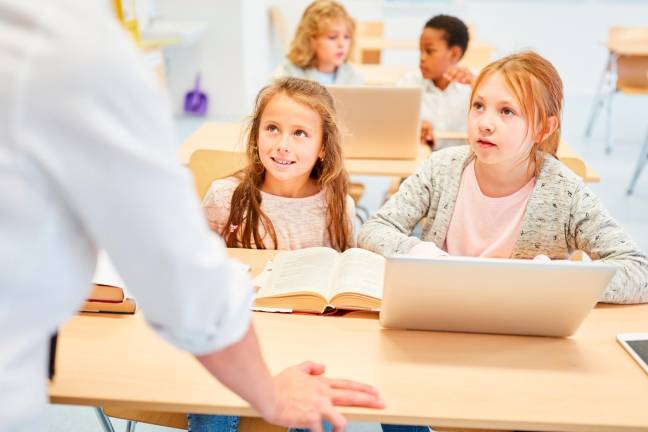Connecting with students on their own turf
TECHNOLOGY. Digital learning brings a whole new world of learning opportunities as well as cautious reminders.



By Christine Urio
Crisp new notebooks, freshly sharpened pencils, and, yes, sleek Chromebooks will cover the desks of students as they head back to school this fall.
Digital learning has become prominent in the classroom, with Chromebooks and iPads being used in place of textbooks and worksheets.
Kelly Manno, the Monroe-Woodbury Social Studies Department chair and eighth-grade teacher, has a class set of Chromebooks so each student has his or her own device.
“We also have a brand new Smart Panel that allows students to interact directly with the entire class,” she said. “It is transforming how we conduct classroom discussions because now all students have the ability to put their answer on the Smart Panel at the same time, rather than me calling on one or two students to answer the question.”
Technology is not just limited to hardware. The applications used by that technology are often as impressive.
Jonathan Redeker, the Goshen School District K-12 technology coordinator, says technology is integral to education in the modern era because teachers must prepare students to think and work using new tools that help them innovate, communicate and collaborate in a global society.
“Chromebooks are the tool of the day for many schools because they are economical, cloud- based, and can have multiple users within a school compared to something like a personalized tablet device,” he said. “Having ubiquitous access to information changes how we live, work, study and play, and helping students to navigate that is an essential part of public schools today.”
Matt Shea, Vernon Township School District’s chief technology officer, feels one of the major benefits of incorporating technology in the classroom is that information is always current.
“We can always find up-to-date information for research, whereas a textbook is out of date the moment it is printed,” he added.
Daniel Novak, director of education in the West Milford Township School District, points out that digital licenses for online textbooks offer enhancements that old paper textbooks do not.
“Students can click on the link to a map, or key terms in glossary can be highlighted, making terms easily accessible and providing a more engaging learning experience,” Novak said.
Technology also helps students interact with information in more engaging ways.
“When we begin reading a piece of Shakespeare, I’ll have students use Chromebooks to access interactive models of the Globe Theater, or view historians reading the plays aloud in the way it would have sounded to audiences in the late 1500s and early 1600s,” said Kirk Thomas, Warwick Valley School District’s 9-12 English and Visual Arts teacher. “We can use various forms of digital content to enhance and enrich the learning experience, deepening the connections students make with the material.”
West Milford’s Novak also finds that one of the major benefits of incorporating technology in the classroom is accessibility.
“Our kids have access to tools at home to continue learning out of the classroom with the ability of sharing on the Google platform,” he added. “Although face-to-face work is important, students can collaborate from home by opening a Google doc and working on group projects from all over, so they don’t have to organize and plan to be in the same place to complete assignments.”
Dr. Michael Rossi, Sparta Township Public School District superintendent, agrees that technology enables effective collaboration.
“Technology reduces many perfunctory tasks, speeds up research and allows us not only to gate keep massive amounts of information at our fingertips, but also receive information in real time so we can connect with anyone, anywhere globally, making us more aware of our surroundings,” he said. “Unfortunately, when misused it can lead to academic problems, and we run the risk of losing some of the human connections if over relied upon.”
Novak agrees that as helpful as technology can be, there are also drawbacks to using it in the classroom.
“Remembering passwords, log ons and websites can get in the way, especially when a teacher wants to teach seamlessly,” he said. “It can get in the way of having to switch, which takes up a lot of class time.”
Tuxedo’s Ferreira noted there can also be technological challenges as well.
“Sometimes the Wi-fi goes down or the bandwidth cannot handle the amount of users at a given time,” she added.
Another issue tied to integrating technology in the classroom is fact checking online sources.
“The challenge with using online resources is that students must be better at sourcing good information,” said Goshen’s Redeker. “Teachers need to help students understand how to check and reference the validity of stories, which is a good life lesson that will transcend schools and help them be better citizens overall.”
Manno, of Monroe-Woodbury, reinforced this is a key challenge.
“We need to teach students to be able to vet sources to determine credibility,” she said. “Actually, this is a skill we all need to be working on, so teachers must help our students to source their information by asking questions like, ‘Can we trust this website? Is it reliable?’”
Learning how to regulate time with technology is also an important skill to learn, and Ferreira also found students and teachers still need the physicality of touching a page.
“Students still need paper and pen because muscle memory helps with the learning process,” she said. “Online textbooks and applications sometimes do not work with a student’s learning style.”
Teachers must also be careful to use technology to transform lessons and not simply to replace pen and paper.
“At first, teachers may substitute technology for pen and paper; they then use technology to augment their lessons,” said Manno. “We are making much better use of technology when we are modifying the lesson using technology and we reach our goal when we redefine our lesson using technology - what does technology allow us to do that we could not achieve before?”
Because of this new frontier, some teachers can feel overwhelmed by the amount of options and resources available.
“Teachers are overwhelmed with extra burdens that take their time, so sometimes it is easier for them to use the resources provided to them rather than sourcing new materials on the internet,” said Goshen’s Redeker.
A new teaching reality is that technology does require an adjustment of how teachers design and implement their lessons.
“I have been teaching Social Studies for 25 years and, at times, this year I have felt more like a first-year teacher as I integrate technology into my classroom,” Manno said. “Some teachers will find it difficult to turn over the learning to their students.”
Ferreira agrees that “for some educators, there is a level of fear and anxiety of the kids knowing more than they do and what if something happens.”
Quite often, students are more technologically savvy than teachers because they are digital natives.
“They grew up in a world where computers, iPhones and social media is the norm,” said Rossi. “We are now connecting with them on their turf.”
Through the connection students have with technology, teachers have found they have grown more engaged in class.
“Students are being born into this world of technology and are digital natives because they are growing up with these devices,” West Milford’s Novak said. “We are teaching a student population who sees technology as a way of doing things, so by incorporating these devices in the classroom, it allows us to work with students in a medium that they are most comfortable with.”
‘“I love reading a textbook,’ said no student ever,” Manno said. “We have access to a world of learning at our fingertips and Chromebooks allow me to put my students in charge of their learning with inquiry as their guide.”
“Technology helps us present students with tasks that ask them to apply their prior knowledge in creative ways as well as explore new information—they feel like they are taking part in rewarding activities,” said Warwick Valley’s Thomas. “I think it also can mirror their digital lives in ways that can guide them to understand the professional and personal boundaries of technology which will be imperative for them to have a firm grasp on as they branch out into the real-world and workforce.”
Like other teachers, Vernon’s Shea has found that the magic of integrating technology is part of a teacher’s toolkit.
“An adept teacher with technology can make an extremely engaging lesson that inspires deep learning by our students,” he said.
“Technology is another resource in our saddlebag,” said Rossi of Sparta. “Nothing will ever replace the teacher.”
Technology is another resource in our saddlebag. Nothing will ever replace the teacher.”